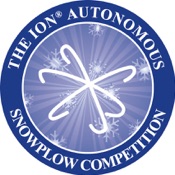


Countdown to 2019
Winter Carnival Events
Home | Objectives | Awards | Venues | Sponsorship | Contact
© Copyright 2009-2019, The Institute of Navigation, Inc. All rights reserved.
® ION is a registered trademark of The Institute of Navigation, Inc.

Each year, teams come up with unique vehicle designs to match the objectives of the competition. This 2019 competition event year has some well established teams, and some very new teams. Each team has prepared a vehicle concept that is anticipated to win the grand prize of the event.
Below are descriptions provided by the teams of their vehicle concept, presenting the unique features and elements of their design that make their concept a winner.
2019 Teams and Their Vehicle Design Approach
Case Western Reserve University (“OTTO XL”): A differential drive robot that uses a Decawave and optical beacon system, an Inertial Measurement Unit (IMU), and wheel encoders to localize itself within the arena, and uses a combination of cameras and a LIDAR for obstacle detection and identification. Path planning combines predefined waypoints with dynamic obstacle avoidance behaviors.
Sponsor: MTD, Inc.
Case Western Reserve University (“Snow Joke”): A snowplow vehicle that has four-wheel skid steer platform with 24V gear motors, driven by low-cost embedded electronics. It aims to fulfill the competition goals while maintaining an
affordable price tag. The robot utilizes the Decawave MDEK1001 development kit to trilaterate multiple points on the
robot to determine position and heading. The robot has been programmed to enjoy cold weather.
Sponsor: MTD, Inc.
Dunwoody College of Technology (“Snow Devils 10012”): The 2019 Snow Devils Team utilizes a two-wheel drive chassis, It uses optical wheel encoders, digital IMU, radar system, and magnetic strip navigation system. The goal this year will be to autonomously plow the snow field and avoid obstacles.
Sponsor: Dunwoody College of Technology, Banner Engineering Corp.
Dunwoody College of Technology (“Wendigo 2019”): The 2019 Wendigo Team utilizes a four-wheel drive chassis that weighs in at approximately 1500 pounds. It uses optical wheel encoders, digital IMU, and six POZYX UWB beacons to autonomously plow the snow field. A Banner radar sensor assists with obstacle avoidance.
Sponsor: Dunwoody College of Technology, Banner Engineering Corp.
Iowa State University Robotics Club (“Iowa State University Cyplow”): The snowplow vehicle is a skid steer robot with a computer vision system to detect obstacles. For localization, it uses ultra-wideband radio beacons. Object detection is accomplished using a SICK LMS-511.
Sponsor: Iowa State University, Deere and Company, Collins Aerospace Companies, SICK, Inc.
North Dakota State University (“Thundar”): An approximately 300 pound autonomous snowplow robot with actuated with two wheel steering and a rear caster wheel. There is a SICK LiDAR sensor for comprehensive obstacle detection at the front of the robot. Positioning and localization are achieved by running a Kalman filter of odometrically processed data from the LiDAR, wheel encoders, and Inertial Measurement Unit (IMU), along with GPS coordinates. Navigation is done through a path planner subsystem of the autonomous software. Software has a Game Evaluator for high level decision making.
Sponsors: National Science Foundation, NDSU Mechanical Engineering Department
University of Michigan, Dearborn (“Yeti IX”): An autonomous vehicle which uses a LiDAR and a stereo camera for vision and obstacle detection. Localization of the robot is achieved using a LiDAR assisted by a set of landmarks. The robot uses preplanned waypoints to navigate across the course. Yeti IX is a four wheel robot and weighs
approximately 300 pounds.
Sponsors: University of Michigan Dearborn College of Engineering and Computer Science, Denso Corporation
University of Minnesota, Twin Cities (“Snow Squirrel”): A compact, electric, track driven vehicle with a steel base and plow, aluminum frame, plastic body panels, and the ability to plow snow by autonomously mapping and navigating an environment. It does this by taking in data on its surroundings with a LiDAR and uses ROSS and Google Cartographer.
Sponsors: University of Minnesota College of Science and Engineering, Nilfisk Group, AMSOIL Inc, TLE Design


